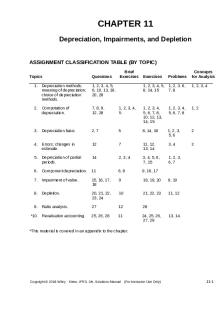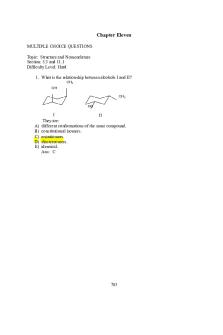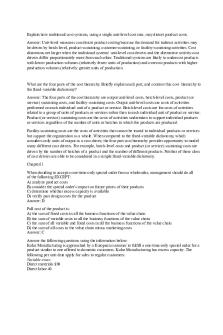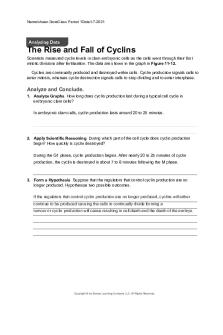CS 22A Summary Ch11 PDF

| Title | CS 22A Summary Ch11 |
|---|---|
| Course | Python Programming for Non-Majors 1 |
| Institution | San José State University |
| Pages | 3 |
| File Size | 93.9 KB |
| File Type | |
| Total Downloads | 70 |
| Total Views | 141 |
Summary
Summary based on lecture and textbook for chapter 11...
Description
CS 22A Summary Ch11 Dictionaries 1. A set of counters a. A dictionary is like a list, but more general b. A set of keys and a set of values. c. Each key maps to a value. d. The association of a key and a value is called a key-value pair or sometimes an item. e. Example: def histogram(s): d = dict() for c in s: if c not in d: d[c] = 1 else: d[c] += 1 return d 2. Looping and dictionaries a. If you use a dictionary in a for statement, it traverses the keys of the dictionary b. Example: def print_hist(h): for c in h: print c, h[c] Here’s what the output looks like: h = histogram('parrot') print_hist(h) a1 p1 r2 t1 o1 3. Reverse lookup a. Given a dictionary d and a key k, it is easy to find the corresponding value v = d[k] b. Example: def reverse_lookup(d, v): for k in d: if d[k] == v: return k raise ValueError 4. Dictionaries and lists
a. Lists can appear as values in a dictionary. b. Example: def invert_dict(d): inv = dict() for key in d: val = d[key] if val not in inv: inv[val] = [key] else: inv[val].append(key) return inv
5. Memos
a. 6. Global variables a. Variables in __main__ are sometimes called global because they can be accessed from any function b. It is common to use global variables for flags
7. Long integers a. Values with type int have a limited range; long integers can be arbitrarily big, but as they get bigger they consume more space and time. b. The mathematical operators work on long integers, and the functions in the math module, too, so in general any code that works with int will also work with long....
Similar Free PDFs

CS 22A Summary Ch11
- 3 Pages

Ch11
- 28 Pages

Ch11 - Solution manual ch11
- 83 Pages

Calc1 CS - Summary Calculus 1
- 10 Pages

Ch11 - kunjaw
- 95 Pages

Ch11 - dsdsdssssssssssssssssssssss
- 97 Pages

Ch11 - nice
- 16 Pages

Ch11 - accounting
- 49 Pages

Review ch11
- 3 Pages

CH11 Outline
- 15 Pages

BIO CH11 Analyzing Data
- 1 Pages

Income Tax Banggawan Ch11
- 10 Pages

SM Ch11 - Answer Key
- 20 Pages
Popular Institutions
- Tinajero National High School - Annex
- Politeknik Caltex Riau
- Yokohama City University
- SGT University
- University of Al-Qadisiyah
- Divine Word College of Vigan
- Techniek College Rotterdam
- Universidade de Santiago
- Universiti Teknologi MARA Cawangan Johor Kampus Pasir Gudang
- Poltekkes Kemenkes Yogyakarta
- Baguio City National High School
- Colegio san marcos
- preparatoria uno
- Centro de Bachillerato Tecnológico Industrial y de Servicios No. 107
- Dalian Maritime University
- Quang Trung Secondary School
- Colegio Tecnológico en Informática
- Corporación Regional de Educación Superior
- Grupo CEDVA
- Dar Al Uloom University
- Centro de Estudios Preuniversitarios de la Universidad Nacional de Ingeniería
- 上智大学
- Aakash International School, Nuna Majara
- San Felipe Neri Catholic School
- Kang Chiao International School - New Taipei City
- Misamis Occidental National High School
- Institución Educativa Escuela Normal Juan Ladrilleros
- Kolehiyo ng Pantukan
- Batanes State College
- Instituto Continental
- Sekolah Menengah Kejuruan Kesehatan Kaltara (Tarakan)
- Colegio de La Inmaculada Concepcion - Cebu


